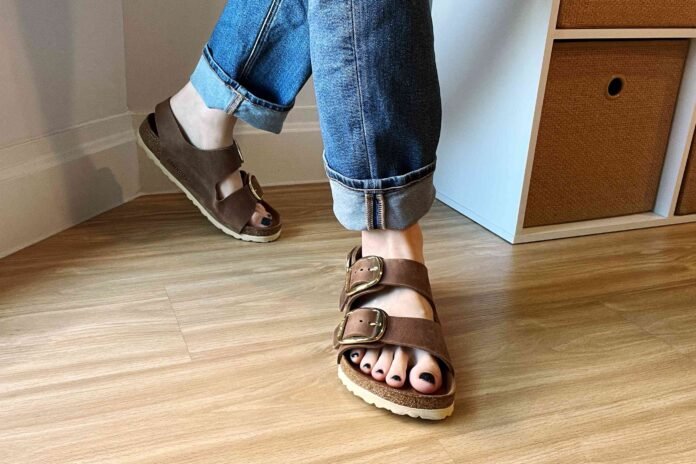Diabetics need to be extra cautious when choosing footwear to prevent complications. Flip-flops are a popular choice because of their convenience, but experts warn that they can be harmful for people with diabetes. Straps can create pressure points on the foot, leading to sores and blisters that are difficult to heal. Open-toe designs make it easier for small stones or gravel to get inside, increasing the risk of foot injuries.
Dr. B Pavan, Head of Podiatry at KIER, Indiranagar, Bangalore, advises against flip-flops for diabetics. He explains that most diabetic patients suffer from peripheral neuropathy, a condition that causes numbness or tingling in the feet. The strap between the great toe and second toe can cause friction wounds in the web space, which may go unnoticed due to reduced sensation. Without proper care, these wounds can lead to infections and serious complications.
Flip-flops also affect foot mechanics. The lack of support forces the smaller toes to grip the footwear tightly during movement. This unnatural toe-clawing increases strain on the foot and can lead to deformities over time. Sliders, which do not have a strap between the toes, may seem like a better option, but they also lack stability. Since they do not provide a secure grip, they can easily slip off, increasing the risk of falls and injuries.
Diabetics should opt for footwear that provides support and protection. Dr. Pavan recommends sliders with a strap at the back, which helps hold the foot in place during movement. A secure fit reduces unnecessary pressure on the foot and prevents injuries. Wide toe boxes, seamless interiors, and soft inner soles are essential features of diabetic-friendly footwear. These elements ensure comfort while minimizing friction and pressure points that could cause wounds.
Diabetic footwear should also have cushioned soles to absorb shock. Hard surfaces can put excessive stress on the feet, increasing the risk of ulcers. A well-padded sole helps distribute pressure evenly, reducing the chances of injuries. Breathable materials are also important. Proper air circulation keeps feet dry and prevents infections, which are more common in diabetic patients.
Regular foot care is crucial for diabetics. Checking the feet daily for cuts, blisters, or redness can help identify potential problems before they worsen. Keeping feet clean and moisturized reduces the risk of dry skin and cracks, which can become entry points for infections. Wearing well-fitted shoes and socks further protects the feet from injuries.
Alternating between two pairs of footwear is also advisable. This allows each pair to dry out completely, preventing bacterial and fungal growth. Durability is another key factor when choosing footwear. Investing in a good-quality pair designed specifically for diabetics can prevent long-term foot problems and improve overall comfort.
Consulting a podiatrist can help diabetics find the right footwear based on their individual needs. Custom orthotics and specially designed diabetic shoes may be necessary for those with severe foot issues. Proper footwear choices can prevent complications, allowing diabetics to stay active and maintain a good quality of life.
Diabetics should prioritize foot health by making informed footwear choices. Flip-flops and regular sliders may not provide the necessary support and protection, increasing the risk of foot problems. Opting for well-structured footwear with secure straps, cushioned soles, and breathable materials ensures comfort and safety. By paying attention to footwear and foot care, diabetics can prevent serious complications and maintain healthy feet for years to come.
Choosing the right footwear is not just about comfort but also about long-term health. Diabetics often experience poor circulation in their feet, which means even minor cuts or pressure points can take longer to heal. In severe cases, untreated wounds can lead to infections and complications that may require medical intervention. Supportive footwear plays a crucial role in preventing such issues by reducing unnecessary strain and ensuring even weight distribution.
In addition to wearing the right footwear, diabetics should also pay attention to their walking surfaces. Uneven terrain, rough surfaces, or sharp objects can easily cause unnoticed injuries. Wearing shoes with a sturdy, well-cushioned sole can help minimize these risks. Shoes that are too tight or too loose can also create friction, leading to blisters and calluses. Ensuring a proper fit is essential to keeping feet healthy.
Another important factor is temperature regulation. Many diabetics experience altered sensation in their feet, making them less aware of extreme temperatures. Walking barefoot on hot pavement or cold surfaces can cause burns or frostbite without the person realizing it. Closed, protective footwear with breathable material helps regulate foot temperature and provides a barrier against environmental hazards.
Moisture management is also essential for diabetic foot health. Sweaty feet trapped in non-breathable shoes create the perfect environment for fungal infections. Opting for moisture-wicking socks along with ventilated footwear can help keep feet dry and reduce the risk of infections like athlete’s foot. Antifungal foot powders and regular foot hygiene practices can further protect against complications.
While style and convenience are important, diabetics must prioritize function and safety when choosing footwear. Many brands now offer stylish yet supportive options that cater to foot health without compromising on aesthetics. Whether it’s casual wear or formal shoes, diabetics should look for well-cushioned, properly fitted, and secure footwear to maintain mobility and overall well-being.

